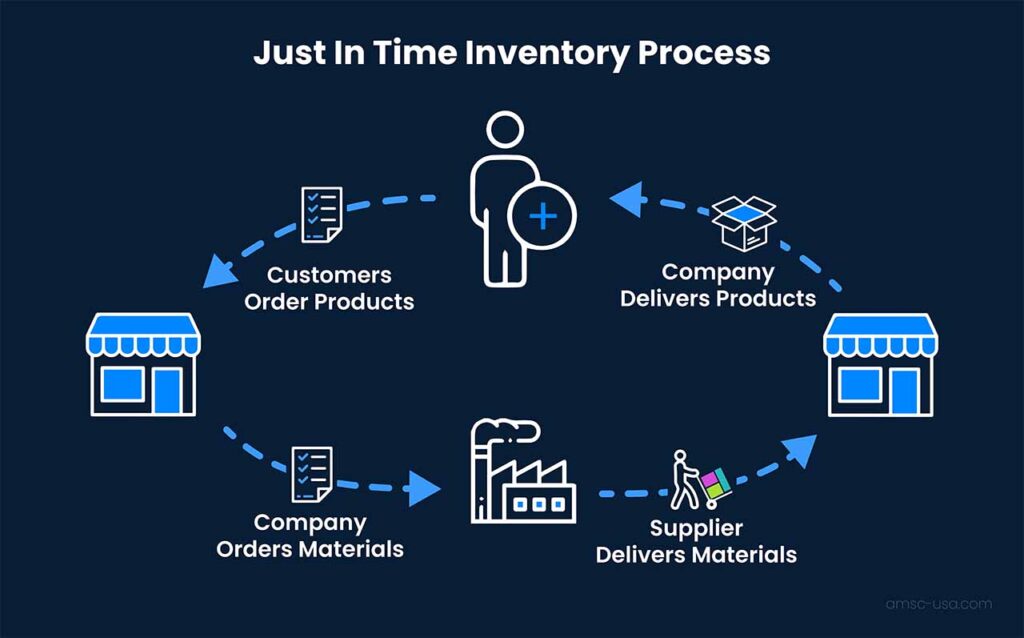Introduction
Just-in-Time (JIT) is a smart way to manage inventory. Instead of stocking piles of unused materials, you only order what you need, right when you need it. This saves money, reduces waste, and keeps your business running smoothly.
But how does it work? And how can you use it in your business?
Additionally, in this guide, we’ll explain it in plain language, show you how to make it work for you, and answer common questions. Whether you make products, sell goods, or manage supplies, it can help you do it better.
Let’s get started!

What Is Just-in-Time (JIT)?
JIT is a way to cut waste by keeping inventory low. You only buy or make things when customers need them. No extra stock sitting around. No wasted money on unused supplies.
Moreover, Toyota first used it in the 1970s to build cars faster and cheaper. Now, businesses everywhere use it, from factories to online stores.
The 5 Key Rules of JIT
- Firstly, no wasted stock – Only order what you’ll use soon.
- Secondly, keep things moving – Avoid production delays.
- Thirdly, make what sells – Don’t guess; let real orders guide you.
- Fourthly, quality first – Mistakes slow everything down.
- Finally, trust your suppliers – Need fast, reliable deliveries.
How to Use JIT in Your Business (Step by Step)
1. Check Your Current Inventory
Firstly, start by looking at what you have now. Ask:
- How much stock just sits there?
- What items run out too fast?
- Where are the slowdowns?
Furthermore, use simple tools like spreadsheets or inventory apps to track this.
If you want to read the How-to Guide Multimodal AI, Click Here
2. Work Closely with Suppliers
Additionally, since it means ordering last-minute, you need suppliers you can count on. Talk to them about:
- Firstly, faster shipping times
- Secondly, smaller, more frequent orders
- Then, backup plans if something goes wrong
3. Let Demand Guide You (Pull System)
Instead of making things and hoping they sell, only produce when there’s an order.
Example:
- A bike shop orders tires only when a customer buys a bike.
- A bakery makes fresh bread based on morning orders, not guesses.
4. Speed Up Your Workflow
Then, smooth, fast production is key. Try these tricks:
- Kaizen (Small Improvements) – Firstly, fix little problems as they come up.
- Kanban (Visual Signals) – Secondly, use cards or apps to show when to make more.
- Lean Methods – Then, cut out steps that don’t add value.
5. Train Your Team
Everyone needs to understand it. Teach them:
- How to switch tasks quickly
- How to spot waste
- What to do if supplies are late
6. Watch and Adjust
Then, it isn’t “set it and forget it.” You must:
- Firstly, track key numbers, like how fast stock sells.
- Secondly, adjust orders if sales change.
- Then, have a backup plan for surprises.
Why JIT Works (The Big Benefits)
Saves Money – Less cash tied up in unused stock.
Less Waste – No expired or outdated goods.
More Space – No crowded storerooms.
Better Quality – Fewer mistakes when you focus on small batches.
The Risks (And How to Avoid Them)
Firstly, supplier Problems – If shipments are late, production stops.
Secondly, wrong Guesses – Order too little, and you run out.
Then, no Backup Plan – One broken link can ruin everything.
Moreover, How to Stay Safe:
- Firstly, keep a tiny emergency stock of key items.
- Secondly, have multiple suppliers.
- Then, use sales data to predict needs.
Real-Life JIT Success Stories
Toyota
Additionally, the company that started JIT cut costs and became a car industry leader.
Dell
Moreover, they built computers only after customers ordered, so nothing gathered dust.
Zara
Then, this fashion brand quickly makes clothes based on trends, not guesses.
JIT vs. Old-School Inventory
| Feature | JIT | Traditional |
|---|---|---|
| Stock Levels | Low | High |
| Cost | Cheaper storage | More storage costs |
| Flexibility | Changes fast | Hard to adjust |
| Risk | Needs good suppliers | Less risky |
FAQ – Quick JIT Questions
1. Can small businesses use JIT?
Yes! Start with one product and a trusted supplier.
2. What’s the #1 JIT mistake?
Relying on just one supplier. Always have a backup.
3. Does JIT work for online stores?
Yes! Dropshipping is JIT, only ship after the sale.
4. How do I start with JIT?
Pick one product, reduce excess stock, and track results.
5. What if sales suddenly jump?
Keep a small safety stock or choose suppliers who can rush orders.
Final Tip
JIT isn’t about being perfect, it’s about getting smarter with inventory. Moreover, start small, learn as you go, and soon you’ll see fewer costs and happier customers.
Ready to try JIT? Pick one thing to improve today!
